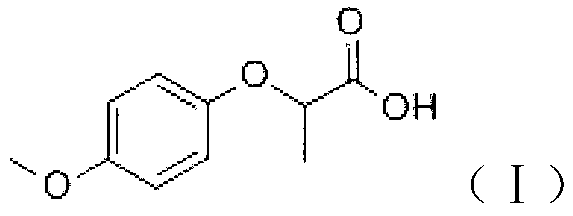Industrial method for synthesizing 2-(4-methoxyphenoxy)-propionic acid through phase transfer
A technology of methoxyphenoxy and phase transfer catalysts, which is applied in the field of food science, can solve the problems of low product purity, high reaction temperature, and high production cost, and achieve the effects of shortening reaction time, improving conversion efficiency, and shortening reaction time
- Summary
- Abstract
- Description
- Claims
- Application Information
AI Technical Summary
Problems solved by technology
Method used
Image
Examples
Embodiment 1
[0031] (1) Add 10kg of p-hydroxyanisole, 11kg of sodium hydroxide, 0.4kg of phase transfer catalyst tetrabutylammonium bromide, and 150L of water into the reaction kettle, stir and mix at normal temperature and pressure, and the stirring speed is 150r / min. After reacting for 15 minutes, p-hydroxyanisole was converted into sodium p-methoxyphenate to obtain mixed material liquid A;
[0032] (2) Add 15kg of 2-chloropropionic acid and 150L of diethyl ether to the mixture liquid A, the reaction temperature is 40°C, the reaction pressure is 3MPa, the stirring speed is 150r / min, and the reaction is 1.5h to obtain the product 2-(4 -methoxyphenoxy)-propionic acid;
[0033] (3) After the reaction, the reaction solution is made acidic with 20% HCl solution, and the aqueous phase and the organic phase are separated by ether, and the 2-(4-methoxyphenoxy)-sodium propionate in the aqueous phase is transformed into 2-(4-methoxyphenoxy)-propionic acid enters the organic phase with diethyl eth...
Embodiment 2
[0036] (1) Add 10kg of p-hydroxyanisole, 20kg of sodium hydroxide, 0.6kg of phase transfer catalyst cyclodextrin, and 200L of water into the reaction kettle, stir and mix at normal temperature and pressure, the stirring speed is 200r / min, and react for 10min. Convert p-hydroxyanisole to sodium p-methoxyphenate to obtain mixed material liquid A;
[0037] (2) Add 15kg of 2-chloropropionic acid and 200L of n-hexane to the mixture liquid A, raise the reaction temperature to 45°C, the pressure is 2MPa, the stirring speed is 200r / min, and react for 1h to obtain the product 2-(4 -methoxyphenoxy)-propionic acid;
[0038] (3) After the reaction, the reaction solution was treated with 15% H 2 SO 4The solution is adjusted to be acidic, and the aqueous phase and the organic phase are separated by n-hexane, and the 2-(4-methoxyphenoxy)-sodium propionate in the aqueous phase is converted into 2-(4-methoxyphenoxy )-propionic acid enters the organic phase, and the organic phase is separate...
Embodiment 3
[0041] (1) Add 10kg of p-hydroxyanisole, 25kg of sodium hydroxide, 0.8kg of phase transfer catalyst cyclodextrin, and 150L of water into the reaction kettle, stir and mix at normal temperature and pressure, the stirring speed is 200r / min, and react for 10min. Convert p-hydroxyanisole to sodium p-methoxyphenate to obtain mixed material liquid A;
[0042] (2) Add 20kg of 2-chloropropionic acid and 160L of petroleum ether to the mixture liquid A, raise the reaction temperature to 40°C, the pressure is 2MPa, the stirring speed is 200r / min, and react for 1h to obtain the product 2-(4 -methoxyphenoxy)-propionic acid;
[0043] (3) After the reaction, the reaction solution was treated with 10% H 2 SO 4 The solution is adjusted to be acidic, and the aqueous phase and the organic phase are separated by petroleum ether, and the 2-(4-methoxyphenoxy)-sodium propionate in the aqueous phase is converted into 2-(4-methoxyphenoxy )-propionic acid enters the organic phase, and the organic ph...
PUM
 Login to View More
Login to View More Abstract
Description
Claims
Application Information
 Login to View More
Login to View More - R&D
- Intellectual Property
- Life Sciences
- Materials
- Tech Scout
- Unparalleled Data Quality
- Higher Quality Content
- 60% Fewer Hallucinations
Browse by: Latest US Patents, China's latest patents, Technical Efficacy Thesaurus, Application Domain, Technology Topic, Popular Technical Reports.
© 2025 PatSnap. All rights reserved.Legal|Privacy policy|Modern Slavery Act Transparency Statement|Sitemap|About US| Contact US: help@patsnap.com



